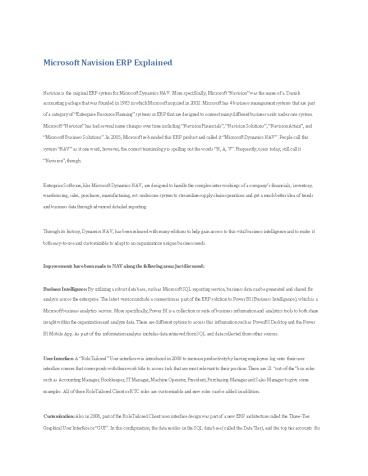Microsoft Navision ERP Explained PowerPoint PPT Presentation
Title: Microsoft Navision ERP Explained
1
Microsoft Navision ERP Explained
Navision is the original ERP system for Microsoft
Dynamics NAV. More specifically, Microsoft
Navision was the name of a Danish accounting
package that was founded in 1983 in which
Microsoft acquired in 2002. Microsoft has 4
business management systems that are part of a
category of Enterprise Resource Planning
systems or ERP that are designed to connect many
different business units under one system.
Microsoft Navision has had several name changes
over time including Navision Financials,
Navision Solutions, Navision Attain, and
Microsoft Business Solutions. In 2005,
Microsoft re-branded this ERP product and called
it Microsoft Dynamics NAV. People call this
system NAV as it one word, however, the correct
terminology is spelling out the words N, A, V.
Frequently, users today, still call it
Navision, though.
Enterprise Software, like Microsoft Dynamics NAV,
are designed to handle the complex inter workings
of a companys financials, inventory, warehousing,
sales, purchases, manufacturing, ect. under one
system to streamline supply chain operations and
get a much better idea of trends and business
data through advanced detailed reporting.
Through its history, Dynamics NAV, has been
released with many editions to help gain access
to this vital business intelligence and to make
it both easy-to-use and customizable to adapt to
an organizations unique business needs.
Improvements have been made to NAV along the
following areas just discussed
Business Intelligence By utilizing a robust data
base, such as Microsoft SQL reporting service,
business data can be generated and shared
for analysis across the enterprise. The latest
version include a connection as part of the ERP
solution to Power BI (Business Intelligence),
which is a Microsoft business analytics service.
More specifically, Power BI is a collection or
suite of business information and analytics tools
to both share insight within the organization and
analyze data. There are different options to
access this information such as PowerBI Desktop
and the Power BI Mobile App. As part of this
information analysis includes data retrieved from
SQL and data collected from other sources.
User Interface A RoleTailored User interface
was introduced in 2008 to increase productivity
by having employees log onto their user interface
screens that corresponds with their work title to
access task that are most relevant to their
position. There are 21 "out-of-the" box roles
such as Accounting Manager, Bookkeeper, IT
Manager, Machine Operator, President, Purchasing
Manager and Sales Manager to give some examples.
All of these RoleTailored Client or RTC roles are
customizable and new roles can be added in
addition.
Customization Also in 2008, part of the
RoleTailored Client user interface design was
part of a new ERP architecture called the
Three-Tier Graphical User Interface or GUI. In
this configuration, the data resides in the SQL
data base (called the Data Tier), and the top
tier accounts for
2
the RTC User Interface called the Client Tier.
The middle tier, is called just that or sometimes
the Server Tier. This Middle Tier is a
multi-tiered environment that is designed to
host and execute all the business logic and makes
a significant departure from the previous 2-tier
ERP architecture. Having this additional layer
makes NAV more scalable and customizable with the
addition of NAVs Web Services which makes it
easy for other authorized programs and systems to
Integrate and tailor the ERP solution to meet the
unique requirements of each business.
Collaboration The latest improvements with
Dynamics NAV "Navision" increasing include the
ability to share vital information across
the enterprise for better decision making. and
knowledge sharing. This is accomplished through
better business intelligence such as PowerBI that
was discussed earlier, and other Microsoft
connected applications such as Microsoft CRM (now
called Dynamics 365 for Sales) Office 365 and
PowerApps which are individual, unique business
functionality used to connection information
without the need of custom software development.
This tight integration with other useful business
applications enhances Dynamics NAV's ability to
easily allow the accessibly of relevant and
actionable information.
New Versions Microsoft Dynamics NAV continues to
be updated and released on a more frequently
basic. The current version is called Dynamics NAV
2018 and has improvements in financial
management, document management, enhanced
business insights, expanded cloud connectivity
with other cloud-based services, plus deeper
integration with other Microsoft applications.
This solution can be deployed either On- Premise
or In-The-Cloud.
The latest ERP release is now taking the
Microsoft Dynamics NAV information, along with
enhancements, to a new Cloud ERP deployment
and is called Microsoft Dynamics 365 Business
Central. Business Central is a cloud solution
built on the rich functionality within Microsoft
Dynamics NAV and adaptable to extend business
applications to other Microsoft Cloud Services
such as Office 365, Microsoft Flow, Power BI,
and PowerApps. Microsoft Dynamics 365 Business
Central Solution can grow as your business
requirements change while taking advantage of
the latest technology-a modern digital business
management solution. Microsoft Navision ERP
Explained

